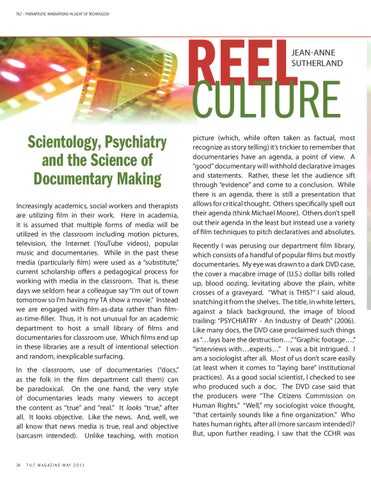TILT – Therapeutic Innovations in Light of Technology
REEL CULTURE
Jean-Anne Sutherland
Scientology, Psychiatry and the Science of Documentary Making Increasingly academics, social workers and therapists are utilizing film in their work. Here in academia, it is assumed that multiple forms of media will be utilized in the classroom including motion pictures, television, the Internet (YouTube videos), popular music and documentaries. While in the past these media (particularly film) were used as a “substitute,” current scholarship offers a pedagogical process for working with media in the classroom. That is, these days we seldom hear a colleague say “I’m out of town tomorrow so I’m having my TA show a movie.” Instead we are engaged with film-as-data rather than filmas-time-filler. Thus, it is not unusual for an academic department to host a small library of films and documentaries for classroom use. Which films end up in these libraries are a result of intentional selection and random, inexplicable surfacing. In the classroom, use of documentaries (“docs,” as the folk in the film department call them) can be paradoxical. On the one hand, the very style of documentaries leads many viewers to accept the content as “true” and “real.” It looks “true,” after all. It looks objective. Like the news. And, well, we all know that news media is true, real and objective (sarcasm intended). Unlike teaching, with motion
34
T I L T MAGAZ I N E MA y 2 0 1 1
picture (which, while often taken as factual, most recognize as story telling) it’s trickier to remember that documentaries have an agenda, a point of view. A “good” documentary will withhold declarative images and statements. Rather, these let the audience sift through “evidence” and come to a conclusion. While there is an agenda, there is still a presentation that allows for critical thought. Others specifically spell out their agenda (think Michael Moore). Others don’t spell out their agenda in the least but instead use a variety of film techniques to pitch declaratives and absolutes. Recently I was perusing our department film library, which consists of a handful of popular films but mostly documentaries. My eye was drawn to a dark DVD case, the cover a macabre image of (U.S.) dollar bills rolled up, blood oozing, levitating above the plain, white crosses of a graveyard. “What is THIS?” I said aloud, snatching it from the shelves. The title, in white letters, against a black background, the image of blood trailing: “PSYCHIATRY - An Industry of Death” (2006). Like many docs, the DVD case proclaimed such things as “…lays bare the destruction…,”“Graphic footage…,” “interviews with…experts…” I was a bit intrigued. I am a sociologist after all. Most of us don’t scare easily (at least when it comes to “laying bare” institutional practices). As a good social scientist, I checked to see who produced such a doc. The DVD case said that the producers were “The Citizens Commission on Human Rights.” “Well,” my sociologist voice thought, “that certainly sounds like a fine organization.” Who hates human rights, after all (more sarcasm intended)? But, upon further reading, I saw that the CCHR was
